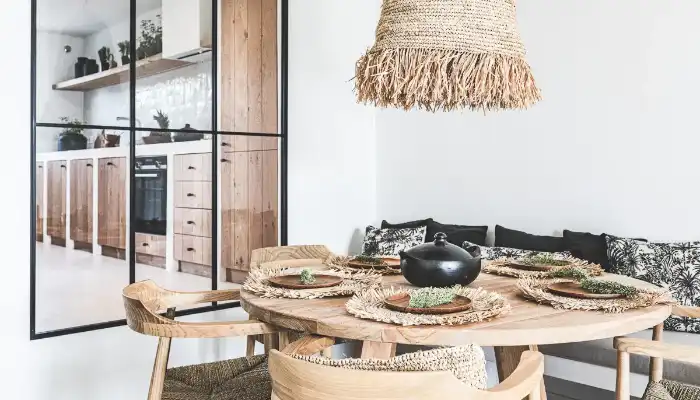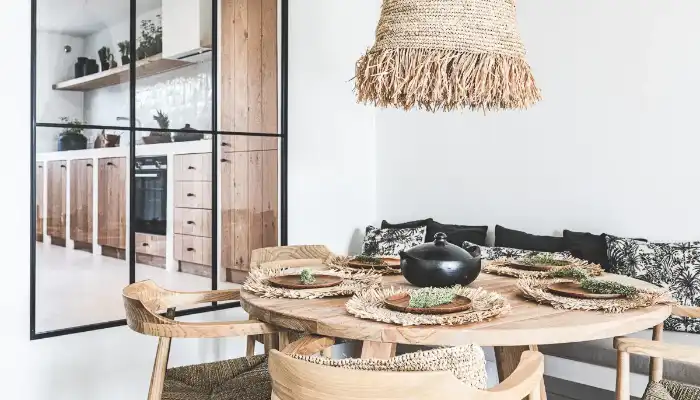
One can imagine moving into a place of quietness and getting immersed in it for some time. The sun rays through a window light up the space decorated with shades of warm wood, and woven floor carpets and carry fern odor. It isn’t just a dream; it’s what natural materials can bring into your home.
Incorporating elements from nature goes beyond mere aesthetics. Some natural materials are not only helpful in terms of fostering healthy environments but also provide timeless styles. Let’s explore further why natural materials should be central to your home design.

Eco-Conscious Choices for a Sustainable Future
The modern design is built on such concepts as “eco-friendly” and “sustainable.” These words represent our commitment to minimize our negative influence on the environment by creating beautiful spaces that are also ecologically responsible. Natural materials hold these values perfectly.
- Nature’s Renewables: Synthetic products derived from fossil fuels differ significantly from renewable resources which include wood, bamboo, and stone. Over time, they get replenished making them environmentally friendly options.
- Reduced Carbon Footprint: Heavy energy consumption and greenhouse gas emissions come with the processing and manufacturing of synthetic materials. They have low processing requirements hence minimized carbon footprints.
- Biodegradable Bliss: At the end of their lifespan, natural materials decompose naturally thus returning to earth without leaving behind harmful toxins or microplastics that pollute our environment.
Sustainable Superstars:
- Bamboo: This rapidly growing grass is an epitome of sustainability because it requires very little water and survives without the need for pesticides unlike hardwood does.
- Reclaimed Wood: Rather than being trendy alone, rejuvenating old lumber is highly sustainable. By incorporating reclaimed wood into your home you’re able to add history while reducing demand on virgin timber sources at the same time.
Breathe Easy in a Natural Sanctuary
Indoor air quality may be impaired by pollutants from cleaning products, furniture emissions, and even dust mites. Natural materials can significantly improve indoor air quality, creating a healthier environment for you and your loved ones.
- Natural Air Purifiers: Plants are living air filters that take in toxins and release clean oxygen, leaving you with fresh breath.
- Reduced VOC Emissions: Many synthetic materials contain volatile organic compounds (VOCs) that irritate the respiratory system. Unlike stone and untreated wood, natural materials emit less VOCs hence leading to a healthier indoors.
- Combating Dust Mites: Synthetic carpets and fabrics are ideal habitats for dust mites. On the other hand, hardwood floors and wool rugs do not provide a friendly environment to these allergens hence fostering more healthy breathing spaces.
Research Reinforces the Benefits:
According to Environmental Health Perspectives research published in their journal recently on human being’s mental health, it was seen that being exposed to woods brings down blood pressure levels as well as stress rates. The University of British Columbia has also found out through its research that individuals who live in homes with nature have better memory performance and overall mental health than those who reside in urban areas.
Timeless Beauty: A Gift from Nature
Natural materials have an inherent aesthetic appeal that makes them unaffected by passing trends. They exude warmth and create organic texture at home by adding one or two natural elements such as stones or timber thereby giving your house an ageless look.
- Nature’s Color Palette: Earthy shades of wood, calm greens from plants, and stone’s cool elegance become a readymade color scheme for a harmonious relaxing space created by nature itself.
- Natural Textures: The feel of natural materials physically enriches a space. The slippery coolness of stones, the wooden grains’ warmth, and the tender clasp of a woven carpet engage the senses and give a feeling of comfort.
- Beauty that Ages Gracefully: Natural materials develop an authentic patina by aging, unlike synthetic ones which appear outmoded after some duration thus adding to their agelessness and aesthetical appeal.
The Strength and Timelessness of Nature: Durability and Longevity
Naturally, things that are made from nature have always been known to last long. For example, items like wood, bricks, or stones can become damaged in no time when used daily as opposed to some synthetic ones. However, with good care, these elements can stand up to the test of time.
Here’s a closer look at why natural materials reign supreme in terms of durability:
- Inherent Strength: Many natural substances possess very strong physical structures. Consider stone for instance; it is nearly impossible to scratch or crack. Likewise, hardwood floors stay beautiful even when they have been walked on for decades.
- Natural Resilience: Wood flooring takes up moisture as well as contracts it back due to dryness keeping the timber from warping or cracking. Stone countertops do not get stained easily neither are they affected by heat hence ideal for busy kitchens.
- Ageless Beauty: Unlike trendy design elements that come and go, natural materials develop a beautiful patina over time. To any space exposed rustic brick walls or weathered reclaimed ceilings beams add that evergreen touch.
A Comparison with Synthetic Materials:
While synthetic materials may offer a lower initial cost, they often fall short when it comes to longevity. Laminate floors are prone to peeling and scratching while vinyl countertops tend to fade over time. Additionally, synthetic materials often lack the inherent strength and resilience of their natural counterparts.
Real-Life Examples of Enduring Natural Materials:
Simply visit any historical monument and you will have a living example of nature’s endurance. Despite being built from limestone and granite centuries ago, the counts as one powerful symbol for Giza’s Great Pyramids. Natural stone is thus remarkable to look at whenever it is used in this way.
Similarly, numerous European cathedrals that were made of wood and stones several centuries ago still remain with people due to their fine details and eternal form. Such timeless buildings are strong reminders of the evergreen quality of any natural materials that could be available in your space.
Beyond Beauty: The Versatility of Natural Materials in Design
However, the beauty that comes with natural materials has further advantages than just strength whereby it is hugely versatile as well. These objects perfectly complement a variety of design styles thereby helping you create a room that defines you.
Natural Materials for Every Design Theme:
- Rustic Charm: Give your space an inviting ambiance using exposed wooden beams, natural stone accents, or woven furnishing pieces.
- Modern Minimalism: Have sleek-looking bamboo floors, polished concrete countertops, and minimalistic blue sculptures among other things that represent neutrality through straight lines.
- Coastal Oasis: Use soft-colored furniture made from trees, seagrass rugs, or decorative items like driftnets hanging around made from shells to attain a quiet oceanic atmosphere indoors.
- Industrial Chic: Get the rawness associated with industrial designs by having walls covered with bricks in some parts while others are left open showing metal work fixtures plus lots of reclaimed wood touches.
Natural Materials for Every Space:
Beyond mere outlook, natural materials can be used in more than one sphere. The latter can be deployed for both interior and exterior design elements to generate a coherent flow throughout your house.
- Interior Design: Natural materials may be utilized for every surface ranging from floors and countertops to wall cladding and furniture. Kitchen wood cabinets, a living room soft wool rug, or an awesome bathroom slate background – the choices are endless.
- Exterior Design: The wild can go beyond your front door. Make a welcoming outdoor area with a flagstone patio, cedar deck, or even a vertical garden full of rich plants.
Unveiling the True Value: Cost-Effectiveness in the Long Term
Even though the initial costs of genuine products may appear high when compared with some synthetic alternatives, it is important to consider their value over time. Here’s why you should use natural materials as an investment in your home:
- Reduced Replacement Costs: Since they are very hardy, real materials are not changed as often; hence this saves money in the long haul. Excellent maintained hardwood floors may last for decades while laminate flooring might need replacement after every five years or after ten years.
- Lower Maintenance Needs: While some need occasional attention, others do not require much maintenance compared to those made from synthetics. Regular cleaning and sealing will keep most of these materials looking good for many years ahead unlike the synthetic ones that demand specialized cleaning products or have components worn out frequently requiring replacement.
- Increased Home Value: The classic appeal and intrinsic quality associated with genuine items significantly raise the price of homes on resale. Potential buyers often offer higher prices just to acquire a house furnished with elements such as hardwood flooring, granite counters, or exposed brick walls.
- Sustainable Choice: There is usually more environmental friendliness about natural substances as opposed to synthetic variants. Numerous organic resources are capable of being reused at the end of their useful lives and many are renewable. Opting for natural materials will not only mean a beautiful, lasting home but also a future that will be more sustainable.
Conclusion
Including natural materials in your home design is an investment made in many ways. From their enduring strength and timeless beauty to their remarkable versatility and surprising cost-effectiveness, natural elements offer a wealth of benefits that synthetic materials simply cannot match. So, the next time you’re planning a home renovation or designing your dream space, consider embracing the enduring allure of natural materials. Not only will you create a space that reflects your unique style and personality, but you’ll also be investing in a home that is built to last and one that complements the natural world around you.
